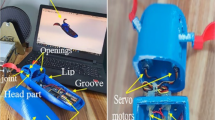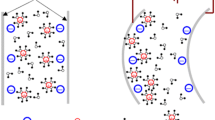Abstract
Bionic manta underwater vehicles will play an essential role in future oceans and can perform tasks, such as long-duration reconnaissance and exploration, due to their efficient propulsion. The manta wings’ deformation is evident during the swimming process. To improve the propulsion performance of the unmanned submersible, the study of the deformation into the bionic pectoral fin is necessary. In this research, we designed and fabricated a flexible bionic pectoral fin, which is based on the Fin Ray® effect with active and passive deformation (APD) capability. The APD fin was actively controlled by two servo motors and could be passively deformed to variable degrees. The APD fin was moved at 0.5 Hz beat frequency, and the propulsive performance was experimentally verified of the bionic pectoral fins equipped with different extents of deformation. These results showed that the pectoral fin with active–passive deformed capabilities could achieve similar natural biological deformation in the wingspan direction. The average thrust (T) under the optimal wingspan deformation is 61.5% higher than the traditional passive deformed pectoral fins. The obtained results shed light on the design and optimization of the bionic pectoral fins to improve the propulsive performance of unmanned underwater vehicles (UUV).










Similar content being viewed by others
Data Availability
The datasets generated during and/or analyzed during the current study are available from the corresponding author upon reasonable request.
References
Youssef, S. M., Soliman, M., Saleh, M. A., Elsayed, A. H., & Radwan, A. G. (2022). Design and control of soft biomimetic pangasius fish robot using Fin Ray effect and reinforcement learning. Scientific Reports, 12(1), 21861.
Lindsey, C. C. (1978). Form, function, and locomotory habits in fish. Fish Physiology, 7, 1–100.
Qiu, H. C., Chen, L. K., Ma, X. S., Bi, S. S., Wang, B., & Li, T. (2023). Analysis of heading stability due to interactions between pectoral and caudal fins in robotic boxfish locomotion. Journal of Bionic Engineering, 20(1), 390–405.
Rosenberger, L. J. (2001). Pectoral fin locomotion in batoid fishes: Undulation versus oscillation. Journal of Experimental Biology, 204(2), 379–394.
Cao, Y., Bi, S. S., Cai, Y. R., & Wang, Y. (2015). Applying central pattern generators to control the robofish with oscillating pectoral fins. Industrial Robot: Industrial Robot, 42, 392–405.
Tytell, E. D. (2004). The hydrodynamics of eel swimming II. Effect of swimming speed. Journal of Experimental Biology, 207(19), 3265–3279.
Tytell, E. D., & Lauder, G. V. (2004). The hydrodynamics of eel swimming: I. Wake structure. Journal of Experimental Biology, 207(11), 1825–1841.
Schaefer, J. T., & Summers, A. P. (2005). Batoid wing skeletal structure: Novel morphologies, mechanical implications, and phylogenetic patterns. Journal of Morphology, 264(3), 298–313.
Fontanella, J. E., Fish, F. E., Barchi, E. I., Campbell-Malone, R., Nichols, R. H., DiNenno, N. K., & Beneski, J. T. (2013). Two- and three-dimensional geometries of batoids in relation to locomotor mode. Journal of Experimental Marine Biology and Ecology, 446, 273–281.
Russo, R. S., Blemker, S. S., Fish, F. E., & Bart-Smith, H. (2015). Biomechanical model of batoid (skates and rays) pectoral fins predicts the influence of skeletal structure on fin kinematics: Implications for bio-inspired design. Bioinspiration & Biomimetics, 10(4), 046002.
Frank, F., Christian, S., Keith, M., Liu, G., Dong, H. B., & Hilary, B. S. (2016). Hydrodynamic performance of aquatic flapping: Efficiency of underwater flight in the manta. Aerospace, 3(3), 20.
Lu, Y., Cao, Y. H., Pan, G., Huang, Q. G., Dong, X., & Cao, Y. (2022). Effect of cross-joints fin on the thrust performance of bionic pectoral fins. Journal of Marine Science and Engineering, 10(7), 869.
Klausewitz, W. (1964). Der lokomotionsmodus der flugelrochen (myliobatoidei). Zoologischer Anzeiger, 173, 110–120.
Rosenberger, L. J., & Westneat, M. W. (1999). Functional morphology of undulatory pectoral fin locomotion in the stingray Taeniura lymma (Chondrichthyes: Dasyatidae). Journal of Experimental Biology, 202(24), 3523–3539.
He, J. J., Cao, Y. H., Huang, Q. G., Pan, G., Dong, X., & Cao, Y. (2022). Effects of bionic pectoral Fin Rays’ spanwise flexibility on forwarding propulsion performance. Journal of Marine Science and Engineering, 10(6), 783.
Zheng, L., Bi, S., Cai, Y., & Niu, C. (2011). Design and optimization of a robotic fish mimicking cow-nosed ray. In 2010 IEEE International Conference on Robotics and Biomimetics (ROBIO), Tianjin, China, 2010, pp. 1075–1080.
Menzer, A., Gong, Y., Fish, F. E., & Dong, H. H. (2022). Bio-inspired propulsion: Towards understanding the role of pectoral fin kinematics in manta-like swimming. Biomimetics, 7(2), 45.
Chen, L. T., Qiao, T., Bi, S. S., Ren, X. W., & Cai, Y. R. (2020). Modeling and simulation research on soft pectoral fin of a bionic robot fish inspired by manta ray. Journal of Mechanical Engineering, 56, 182–190. https://doi.org/10.3901/jme.2020.19.182
Chew, C. M., Lim, Q. Y., & Yeo, K. S. (2015). Development of propulsion mechanism for robot manta ray. IEEE International Conference on Robotics and Biomimetics (ROBIO), 2015, 1918–1923.
Moored, K. W., Kemp, T. H., Houle, N. E., & Bart-Smith, H. (2011). Analytical predictions, optimization, and design of a tensegrity-based artificial pectoral fin. International Journal of Solids and Structures, 48(22–23), 3142–3159. https://doi.org/10.1016/j.ijsolstr.2011.07.008
Moored, K. W., Fish, F. E., Kemp, T. H., & Bart-Smith, H. (2011). Batoid fishes: Inspiration for the next generation of underwater robots. Marine Technology Society Journal, 45(4), 99–109.
Xing, C., Cao, Y., Cao, Y. H., Pan, G., & Huang, Q. (2022). Asymmetrical oscillating morphology hydrodynamic performance of a novel bionic pectoral fin. Journal of Marine Science and Engineering, 10(2), 289.
Zhang, Y. X., Wang, S. P., Wang, X. J., & Geng, Y. X. (2018). Design and control of bionic manta ray robot with flexible pectoral fin. In 2018 IEEE 14th International Conference on Control and Automation (ICCA), Alaska, USA, 2018, pp. 1034–1039.
Cai, Y. R., Bi, S. S., Li, G. Y., Hildre, H. P., & Zhang, H. X. (2018). From natural complexity to biomimetic simplification: The realization of bionic fish inspired by the cownose ray. IEEE Robotics & Automation Magazine, 26(3), 27–38.
Kellaris, N., Gopaluni Venkata, V., Smith, G. M., Mitchell, S. K., & Keplinger, C. (2018). Peano-HASEL actuators: Muscle-mimetic, electrohydraulic transducers that linearly contract on activation. Science Robotics, 3(14), eaar3276.
Hubbard, J. J., Fleming, M., Palmre, V., Pugal, D., Kim, K. J., & Leang, K. K. (2013). Monolithic IPMC fins for propulsion and maneuvering in bioinspired underwater robotics. IEEE Journal of Oceanic Engineering, 39(3), 540–551.
Li, T., Li, G. R., Liang, Y. M., Cheng, T. Y., Dai, J., Yang, X. X., Liu, B. Y., Zeng, Z. D., Huang, Z. L., Luo, Y. W., Xie, T., & Yang, W. (2017). Fast-moving soft electronic fish. Science Advances, 3(4), e1602045. https://doi.org/10.1126/sciadv.1602045
Huang, W., Hongjamrassilp, W., Jung, J.-Y., Hastings, P. A., Lubarda, V. A., & McKittrick, J. (2017). Structure and mechanical implications of the pectoral fin skeleton in the longnose skate (Chondrichthyes, Batoidea). Acta biomaterialia, 51, 393–407.
Wang, Z. L., Wang, Y. W., Li, J. A., Hang, G. R., IEEE. (2009). A micro biomimetic manta ray robot fish actuated by SMA. IEEE. https://doi.org/10.1109/robio.2009.5420423
Lauder, G. V., Madden, P. G. A., Tangorra, J. L., Anderson, E., & Baker, T. V. (2011). Bioinspiration from fish for smart material design and function. Smart Materials and Structures. https://doi.org/10.1088/0964-1726/20/9/094014
Eftekhari, M., Rahmanian, S., & Moradi, P. (2017). Analysis of bio-inspired kinematic patterns pectoral fin with shape memory alloy (SMA). American Journal of Data Mining and Knowledge Discovery, 2(1), 1–7.
Seok, S., Onal, C. D., Cho, K.-J., Wood, R. J., Rus, D., & Kim, S. (2012). Meshworm: A peristaltic soft robot with antagonistic nickel titanium coil actuators. IEEE/ASME Transactions on Mechatronics, 18(5), 1485–1497.
Kim, H.-S., Heo, J.-K., Choi, I.-G., Ahn, S.-H., & Chu, W.-S. (2021). Shape memory alloy-driven undulatory locomotion of a soft biomimetic ray robot. Bioinspiration & Biomimetics, 16(6), 066006.
Ionov, L. (2014). Hydrogel-based actuators: Possibilities and limitations. Materials Today, 17(10), 494–503.
Suzumori, K., Endo, S., Kanda, T., Kato, N., & Suzuki, H. (2007). A bending pneumatic rubber actuator realizing soft-bodied manta swimming robot. In Proceedings 2007 IEEE International Conference on Robotics and Automation, Roma, Italy, 2007, pp. 4975–4980.
Wehner, M., Truby, R. L., Fitzgerald, D. J., Mosadegh, B., Whitesides, G. M., Lewis, J. A., & Wood, R. J. (2016). An integrated design and fabrication strategy for entirely soft, autonomous robots. Nature, 536(7617), 451–455.
Park, S.-J., Gazzola, M., Park, K. S., Park, S., Di Santo, V., Blevins, E. L., et al. (2016). Phototactic guidance of a tissue-engineered soft-robotic ray. Science, 353, 158–162.
Nawroth, J. C., Lee, H., Feinberg, A. W., Ripplinger, C. M., McCain, M. L., Grosberg, A., et al. (2012). A tissue-engineered jellyfish with biomimetic propulsion. Nature Biotechnology, 30(8), 792–797.
Brower, T. P. (2006). Design of a manta ray inspired underwater propulsive mechanism for long range, low power operation. Medford: Tufts University.
Chen, L. K., Bi, S. S., Cai, Y. R., Cao, Y., & Pan, G. (2022). Design and experimental research on a bionic robot fish with tri-dimensional soft pectoral fins inspired by cownose ray. Journal of Marine Science and Engineering, 10(4), 537.
Hosale, M., & Kievid, C. (2010). Modulating territories, penetrating boundaries. Footprint, 55–68.
Pfaff, O., Simeonov, S., Cirovic, I., & Stano, P. (2011). Application of Fin Ray effect approach for production process automation. Annals of DAAAM & Proceedings, 22(1), 1247–1249.
Zhou, L., Ren, L. L., Chen, Y., Niu, S. C., Han, Z. W., & Ren, L. Q. (2021). Bio-inspired soft grippers based on impactive gripping. Advanced Science. https://doi.org/10.1002/advs.202002017
Berlinger, F., Saadat, M., Haj-Hariri, H., Lauder, G., & Nagpal, R. (2021). Fish-like three-dimensional swimming with an autonomous, multi-fin, and biomimetic robot. Bioinspiration & Biomimetics, 16(2), 026018.
Aiello, B. R., Hardy, A. R., Cherian, C., Olsen, A. M., Ahn, S. E., Hale, M. E., & Westneat, M. W. (2018). The relationship between pectoral Fin Ray stiffness and swimming behavior in Labridae: insights into design, performance and ecology. Journal of Experimental Biology, 221(1), jeb163360.
Manoonpong, P., Rajabi, H., Larsen, J. C., Raoufi, S. S., Asawalertsak, N., Homchanthanakul, J., et al. (2022). Fin Ray crossbeam angles for efficient foot design for energy-efficient robot locomotion. Advanced Intelligent Systems, 4(1), 2100133.
Acknowledgements
This work was supported by the National Key Research and Development Program (Grant no. 2022YFC2805200, 2020YFB1313200); the National Natural Science Foundation of China (Grant no. 52001260, 52201381, 52371338); Ningbo Natural Science Foundation (Grant no. 2022J062).
Author information
Authors and Affiliations
Corresponding author
Ethics declarations
Conflict of interest
The authors have no financial or proprietary interests in any material discussed in this article, and the authors have no competing interests to declare relevant to this article's content.
Additional information
Publisher's Note
Springer Nature remains neutral with regard to jurisdictional claims in published maps and institutional affiliations.
Rights and permissions
Springer Nature or its licensor (e.g. a society or other partner) holds exclusive rights to this article under a publishing agreement with the author(s) or other rightsholder(s); author self-archiving of the accepted manuscript version of this article is solely governed by the terms of such publishing agreement and applicable law.
About this article
Cite this article
Lu, Y., Meng, S., Xing, C. et al. Effect of Active–Passive Deformation on the Thrust by the Pectoral Fins of Bionic Manta Robot. J Bionic Eng 21, 718–728 (2024). https://doi.org/10.1007/s42235-023-00463-6
Received:
Revised:
Accepted:
Published:
Issue Date:
DOI: https://doi.org/10.1007/s42235-023-00463-6




